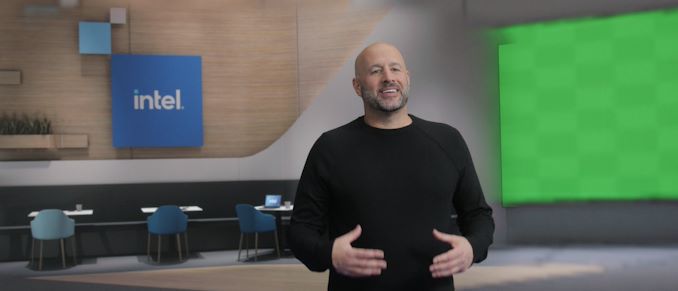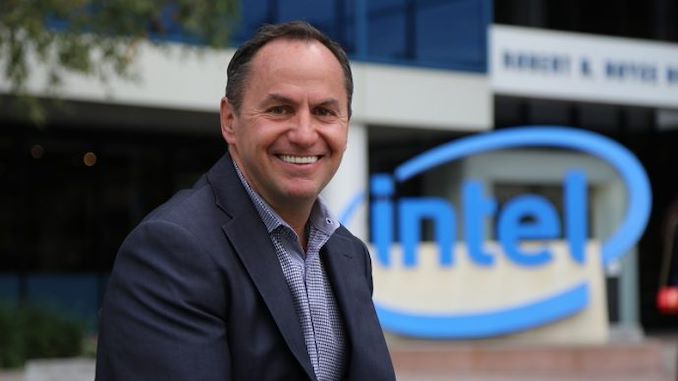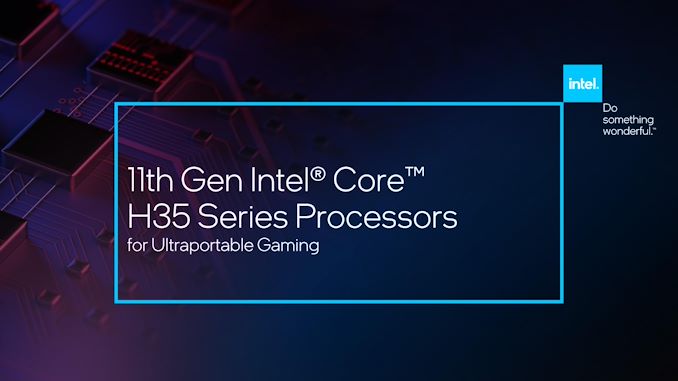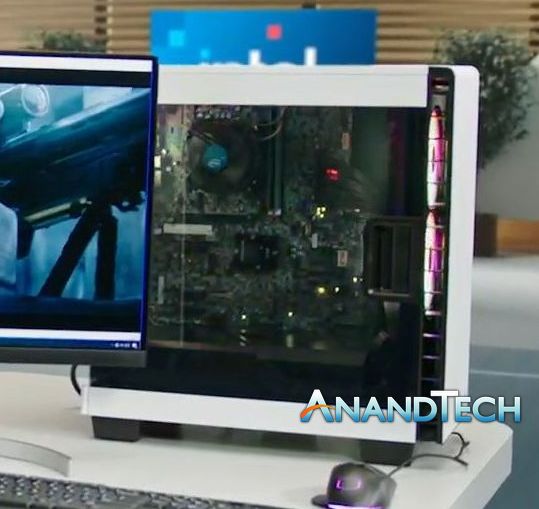Intel at CES 2021: Ice, Tiger, Rocket, Jasper, and Alder Lake
by Dr. Ian Cutress on January 11, 2021 4:32 PM EST
Despite only having a 30 minute press event at this year’s annual CES trade show, Intel had a lot to discuss about its plans through the next 12 months. The company touched upon five key processor architectures and product segments that will dictate where a lot of its FY2021 will come from. This is essentially a yearly roadmap set of announcements, without actually giving us the roadmap.
Carousel Image is of Intel's Greg Bryant, GM of the Client Computing Group, presenting at CES.
We’ve had a lot of Intel news today, which we separated out into separate news posts for ease of use. This is a handy quick-use guide to click through to any of our analysis
An Evening with Intel CEO Bob Swan: Roundtable Q&A
Intel surprised us by offering a chance to ask questions to the man in charge, CEO Bob Swan. It is rare for Intel to offer access to its C-Level executives to the tech press, and as a result we had to think of some nail biters to ask him that only he could answer. Our time was short, and ended up being about 15 minutes for the half-dozen of us to ask and get answers, but it was good to hear answers relating to Intel’s fab strategy, what Intel can do when it comes to outsourcing, and whether Bob considers Intel’s technical or financial position as more important.
Hot Off The Press: Ice Lake Xeon Now In Production
Many of Intel’s recent challenges stems from its inability to drive its 10nm process into two of the key revenue generating areas for the company: desktop and server. We were expecting to see Intel’s 10nm Ice Lake Xeon Scalable at the end of last year, but it passed by without a peep. Today Intel is announcing that it has started production, although earlier in the year Intel said it was already ramping production, and other sources tell us that Intel has already launched the hardware, and is shipping to customers? It all got very confusing.
The Newest Desktop On The Block: Rocket Lake’s Core i9-11900K
Intel has been teasing its next generation Rocket Lake desktop processors for several months now, with arrows pointing to PCIe 4.0 and we already know about the backported CPU and GPU cores. There are big questions as to what this means for performance and power, and Intel answered exactly zero of our questions, but did decide to preview some of the gaming performance, as well as give us concrete numbers on frequencies. There’s also a launch of many, many 500-series motherboards.
Laptops Now Have Options: Tiger Lake 35W, Tiger Lake 45W
On the notebook side of the equation, Intel has two new product families for its OEM partners to play with. The closest to launch is the new Tiger Lake H35 series, which are Intel’s regular 15 W processors beefed up to a 35 W power mode, and scraping 5.0 GHz. A little further away is the traditional 45W H-Series processors, featuring up to eight cores. We’ve got details on both.
Business Customers Matter Too: Intel Tiger Lake gets vPro
Given the massive growth of notebook sales this year to the business sector, demand for business class notebooks is growing fast. These business notebooks need special security features, as well as out-of-band management, and thus require Intel’s vPro line of hardware. Intel is meeting that need by putting the latest 15W Tiger Lake processors into its vPro line. More details of the additional security features that come with the hardware, such as CET, in our coverage.
Chromebooks for Education: 10nm Jasper Lake Comes To Life
Here’s an announcement we weren’t really expecting to get in detail, but we’re glad we did: Intel is updating its Pentium Silver and Celeron processor line with 10nm Jasper Lake processors. What makes this an exciting launch is that these are powered by Intel’s latest generation Tremont Atom cores that do x86 a little differently than most. We can’t wait to get our hands on one, especially as they filter into Windows machines and mini-PCs. More details inside.
Alder Lake?
Mentioned briefly in our pre-show discussions under NDA at the time, while there’s no specific news on Intel’s Alder Lake platform coming later in 2021, CEO Bob Swan did tell us that it will be Intel’s most ‘power scalable’ SoC for desktop and mobile. More details to follow later in the year.
Update: Intel showed off this system during their CES press conference.
Intel said it was an Alder Lake system, up and running with Windows. Obviously early silicon and a test board so far, but it's a step in the right direction. It was confirmed for launch in the second half of the year.
Related Reading
- Interview with Intel CEO Bob Swan
- Intel at CES 2021: Overview
- Intel at CES 2021: Press Event Live Blog
- Intel Ice Lake Xeon in Production
- Intel 11th Gen Desktop Rocket Lake Core i9-11900K ‘Preview’
- Intel 11th Gen Tiger Lake-U Boosted to 35W
- Intel 11th Gen Tiger Lake-H with 8 cores
- Intel 11th Gen Tiger Lake Goes vPro
- Intel’s Next Gen Tremont Atom in Jasper Lake for Q1

















44 Comments
View All Comments
Smell This - Monday, January 11, 2021 - link
"Intel answered exactly zero of our questions""I'm SHOCKED!" said no one.
FreckledTrout - Monday, January 11, 2021 - link
Intel inside, because they are scared.milkywayer - Monday, January 11, 2021 - link
Seeing intel struggle to come up with a proper competition to AMD makes me happy and will hopefully make up for the years and years of milking intel did with the artificial limiting of 4 cores. Intel kept 6 cores and higher at a premium when it could to squeeze out every last penny from the market back then. This kinda karma is rare to see and it makes me happy. They also kept ECC ram out of consumer markets for years - go read the Ars article on that if you think like I did how it was unnecessary because intel marketed it for pros only for the Extra $$$. Scree you intel execs. You deserve this beating from amd and apple now.lmcd - Tuesday, January 12, 2021 - link
Intel didn't artificially limit 4 cores, they fixed the massive problem of PC power consumption and lack of idle states and sleep states. They destroyed AMD by properly manufacturing on-chip and on-die components, for example their on-chip memory controller substantially outperformed AMD's for years and still has better support for mismatched modules to this day.AMD bet on a huge architecture in Bulldozer, and Intel punished them. Now AMD has a compact architecture and higher yield dies, and is punishing Intel. It's really not that deep. But don't act like Intel didn't massively improve processors over the last decade. It's just the last 2 years that have been truly abysmal, and that was certainly not deliberate.
DanD85 - Tuesday, January 12, 2021 - link
Lol, the Intel spinning level of this comment is of epic proportion! Intel performance has been stagnating for a decade while AMD, with a much smaller scale and budget, managed to almost double its CPU performance in 3 years! Imagine what we could have had if Intel also thought of pushing performance besides squeezing everyone for as many mullars as possible!lmcd - Tuesday, January 12, 2021 - link
While we're at it, jet fuel can't melt steel beams!10% performance increase, 20 W decreased power: https://www.anandtech.com/bench/product/2703?vs=27...
https://www.anandtech.com/bench/product/287?vs=155... additional benchmarks.
Apparently Intel should've sandbagged a couple years instead of posting consistent year over year improvement. It's honestly pathetic how deeply you hate Intel.
flashmozzg - Tuesday, January 12, 2021 - link
All attributed almost entirely to a 22 -> 14nm switch.lmcd - Wednesday, January 13, 2021 - link
Early 14nm left a lot on the table. Intel's struggles didn't start with 10nm.damianrobertjones - Saturday, January 16, 2021 - link
This is business? Why spend cash when your products are selling and BEATING the competition?DigitalFreak - Tuesday, January 12, 2021 - link
Where'd you get that weed you're smoking?